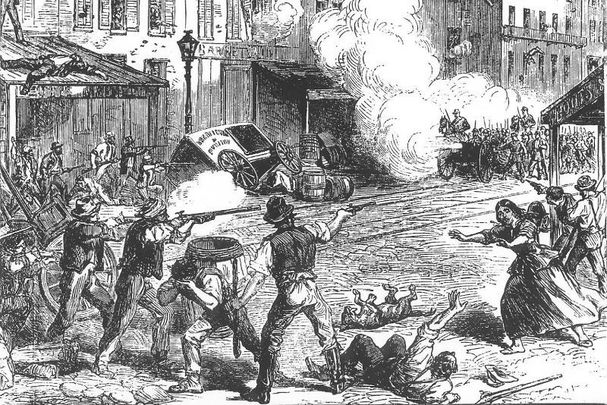A couple of weeks back, The New York Times ran an opinion piece by author Elizabeth Mitchell titled “The Real Story of the ‘Draft Riots’”
*Editor's Note: This column first appeared in the March 3 edition of the Irish Voice newspaper, sister publication to IrishCentral.
“Many people today,” Mitchell wrote, “probably know (the riots) as a violent citizens’ revolt against President Abraham Lincoln’s 1863 conscription of soldiers. In Martin Scorsese’s Gangs of New York, inspired by the nonfiction book by Herbert Asbury, what happened over those days comes across as a somewhat entertaining if gory battle between rival white gangs.”
The truth, for Mitchell, “is that...mobs of white New Yorkers roamed the streets of the city...targeting black people for the most horrific violence.”
The horrors of July 1863 were without question one of the most awful chapters of racial violence in U.S. history.
But to leave it at that undermines Mitchell’s own stated purpose - to have “a clear-eyed view of our own history.”
For example, the degree to which Irish immigrants and their children participated in the Draft Riots has long been up for debate. Perhaps that’s why Mitchell makes no mention at all of how immigration -- or religion, or class, or party politics -- influenced the violence.
New York Tribune editor Horace Greeley, for one, called out Irish-born Archbishop “Dagger” John Hughes, accusing “your people” of the racism that fueled the riots and the Civil War overall.
Decades later, How the Other Half Lives author Jacob Riis struck a (slightly) more sympathetic tone.
“A vast majority of the rioters were Irish simply because the gangsters and the other criminal elements of the city were largely of that race,” he wrote.
Riis notes in “some quarters it was declared that the riots were a Roman Catholic insurrection.” As evidence, he notes “the burning and looting of the Methodist Episcopal Mission at the Five Points by a mob which shouted the glories of the Pope and carried banners inscribed ‘Down with Protestants.’”
Read more
But Mitchell and many others view this history in almost Puritanical terms: there were saints and sinners, good guys and bad guys, and that’s that.
It’s like the way a “law and order” Trump fan looks at crime in, well, black and white terms. Punish the bad guys and don’t give me any garbage about other factors or extenuating circumstances!
Mitchell does not mention -- no surprise -- that the draft rioters’ rage coincided with the infamous anti-Catholic celebrations of July 12 which, to this day, get ugly in Northern Ireland.
Yet Mitchell also does not mention that Lincoln’s plan for the “conscription of soldiers” allowed the wealthy to buy their way out of the draft, something a poor laborer, immigrant or native-born, could never do.
You’d think someone attempting to make an argument for a more just view of history would mention something as unjust as that.
For a long time, the Draft Riots have been used to support the claim that Irish immigrants participated in such heinous acts to “become” white.
But in ignoring many other factors about the Draft Riots, Mitchell herself “whitens” these immigrants, implying that a slave-owning plantation master from Georgia, and an unemployed laborer from Famine-ravaged Skibbereen are indistinguishable parts of the same dominant culture.
Failing to account for the many factors that go into any such disturbances all but guarantees a misunderstanding of both the past and the present.
Horace Greeley, for example, was not wrong that the urban Irish were aligned with the Democratic Party -- which, in the South, was the party of slavery.
But one reason they were is because the competing Republican Party was loaded with rabid anti-immigrant, anti-Catholic types whose disdain for big city foreigners has lasted quite a few years, you might have noticed.
These alignments are complicated, messy, ugly. But ignoring or simplifying them brings us no closer to understanding, or avoiding a repeat, of horrors like the Draft Riots.
(Contact “Sidewalks” at tdeignan.blogspot.com)




Comments